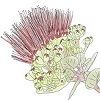6.3: Non-vascular plants
- Page ID
- 59240
\( \newcommand{\vecs}[1]{\overset { \scriptstyle \rightharpoonup} {\mathbf{#1}} } \)
\( \newcommand{\vecd}[1]{\overset{-\!-\!\rightharpoonup}{\vphantom{a}\smash {#1}}} \)
\( \newcommand{\id}{\mathrm{id}}\) \( \newcommand{\Span}{\mathrm{span}}\)
( \newcommand{\kernel}{\mathrm{null}\,}\) \( \newcommand{\range}{\mathrm{range}\,}\)
\( \newcommand{\RealPart}{\mathrm{Re}}\) \( \newcommand{\ImaginaryPart}{\mathrm{Im}}\)
\( \newcommand{\Argument}{\mathrm{Arg}}\) \( \newcommand{\norm}[1]{\| #1 \|}\)
\( \newcommand{\inner}[2]{\langle #1, #2 \rangle}\)
\( \newcommand{\Span}{\mathrm{span}}\)
\( \newcommand{\id}{\mathrm{id}}\)
\( \newcommand{\Span}{\mathrm{span}}\)
\( \newcommand{\kernel}{\mathrm{null}\,}\)
\( \newcommand{\range}{\mathrm{range}\,}\)
\( \newcommand{\RealPart}{\mathrm{Re}}\)
\( \newcommand{\ImaginaryPart}{\mathrm{Im}}\)
\( \newcommand{\Argument}{\mathrm{Arg}}\)
\( \newcommand{\norm}[1]{\| #1 \|}\)
\( \newcommand{\inner}[2]{\langle #1, #2 \rangle}\)
\( \newcommand{\Span}{\mathrm{span}}\) \( \newcommand{\AA}{\unicode[.8,0]{x212B}}\)
\( \newcommand{\vectorA}[1]{\vec{#1}} % arrow\)
\( \newcommand{\vectorAt}[1]{\vec{\text{#1}}} % arrow\)
\( \newcommand{\vectorB}[1]{\overset { \scriptstyle \rightharpoonup} {\mathbf{#1}} } \)
\( \newcommand{\vectorC}[1]{\textbf{#1}} \)
\( \newcommand{\vectorD}[1]{\overrightarrow{#1}} \)
\( \newcommand{\vectorDt}[1]{\overrightarrow{\text{#1}}} \)
\( \newcommand{\vectE}[1]{\overset{-\!-\!\rightharpoonup}{\vphantom{a}\smash{\mathbf {#1}}}} \)
\( \newcommand{\vecs}[1]{\overset { \scriptstyle \rightharpoonup} {\mathbf{#1}} } \)
\( \newcommand{\vecd}[1]{\overset{-\!-\!\rightharpoonup}{\vphantom{a}\smash {#1}}} \)
\(\newcommand{\avec}{\mathbf a}\) \(\newcommand{\bvec}{\mathbf b}\) \(\newcommand{\cvec}{\mathbf c}\) \(\newcommand{\dvec}{\mathbf d}\) \(\newcommand{\dtil}{\widetilde{\mathbf d}}\) \(\newcommand{\evec}{\mathbf e}\) \(\newcommand{\fvec}{\mathbf f}\) \(\newcommand{\nvec}{\mathbf n}\) \(\newcommand{\pvec}{\mathbf p}\) \(\newcommand{\qvec}{\mathbf q}\) \(\newcommand{\svec}{\mathbf s}\) \(\newcommand{\tvec}{\mathbf t}\) \(\newcommand{\uvec}{\mathbf u}\) \(\newcommand{\vvec}{\mathbf v}\) \(\newcommand{\wvec}{\mathbf w}\) \(\newcommand{\xvec}{\mathbf x}\) \(\newcommand{\yvec}{\mathbf y}\) \(\newcommand{\zvec}{\mathbf z}\) \(\newcommand{\rvec}{\mathbf r}\) \(\newcommand{\mvec}{\mathbf m}\) \(\newcommand{\zerovec}{\mathbf 0}\) \(\newcommand{\onevec}{\mathbf 1}\) \(\newcommand{\real}{\mathbb R}\) \(\newcommand{\twovec}[2]{\left[\begin{array}{r}#1 \\ #2 \end{array}\right]}\) \(\newcommand{\ctwovec}[2]{\left[\begin{array}{c}#1 \\ #2 \end{array}\right]}\) \(\newcommand{\threevec}[3]{\left[\begin{array}{r}#1 \\ #2 \\ #3 \end{array}\right]}\) \(\newcommand{\cthreevec}[3]{\left[\begin{array}{c}#1 \\ #2 \\ #3 \end{array}\right]}\) \(\newcommand{\fourvec}[4]{\left[\begin{array}{r}#1 \\ #2 \\ #3 \\ #4 \end{array}\right]}\) \(\newcommand{\cfourvec}[4]{\left[\begin{array}{c}#1 \\ #2 \\ #3 \\ #4 \end{array}\right]}\) \(\newcommand{\fivevec}[5]{\left[\begin{array}{r}#1 \\ #2 \\ #3 \\ #4 \\ #5 \\ \end{array}\right]}\) \(\newcommand{\cfivevec}[5]{\left[\begin{array}{c}#1 \\ #2 \\ #3 \\ #4 \\ #5 \\ \end{array}\right]}\) \(\newcommand{\mattwo}[4]{\left[\begin{array}{rr}#1 \amp #2 \\ #3 \amp #4 \\ \end{array}\right]}\) \(\newcommand{\laspan}[1]{\text{Span}\{#1\}}\) \(\newcommand{\bcal}{\cal B}\) \(\newcommand{\ccal}{\cal C}\) \(\newcommand{\scal}{\cal S}\) \(\newcommand{\wcal}{\cal W}\) \(\newcommand{\ecal}{\cal E}\) \(\newcommand{\coords}[2]{\left\{#1\right\}_{#2}}\) \(\newcommand{\gray}[1]{\color{gray}{#1}}\) \(\newcommand{\lgray}[1]{\color{lightgray}{#1}}\) \(\newcommand{\rank}{\operatorname{rank}}\) \(\newcommand{\row}{\text{Row}}\) \(\newcommand{\col}{\text{Col}}\) \(\renewcommand{\row}{\text{Row}}\) \(\newcommand{\nul}{\text{Nul}}\) \(\newcommand{\var}{\text{Var}}\) \(\newcommand{\corr}{\text{corr}}\) \(\newcommand{\len}[1]{\left|#1\right|}\) \(\newcommand{\bbar}{\overline{\bvec}}\) \(\newcommand{\bhat}{\widehat{\bvec}}\) \(\newcommand{\bperp}{\bvec^\perp}\) \(\newcommand{\xhat}{\widehat{\xvec}}\) \(\newcommand{\vhat}{\widehat{\vvec}}\) \(\newcommand{\uhat}{\widehat{\uvec}}\) \(\newcommand{\what}{\widehat{\wvec}}\) \(\newcommand{\Sighat}{\widehat{\Sigma}}\) \(\newcommand{\lt}{<}\) \(\newcommand{\gt}{>}\) \(\newcommand{\amp}{&}\) \(\definecolor{fillinmathshade}{gray}{0.9}\)Non-vascular plants are a diverse group of plants with approximately 20,000 living species presenting a wide geographical distribution, ranging from tropical forests to high-latitude tundra, to high mountain ranges. They are the most ancient group of land plants, being the closest relatives to green algae and the earliest diverging lineages of land plants. Informally, they are called “bryophytes” which include mosses, liverworts, and hornworts. In this chapter, you will see the term used to refer to non-vascular plants.
Bryophytes can grow in a variety of substrates, like rocks, tree stems, or fallen logs. They are an important part of the environment because of their ability to grow on bare surfaces, interact with non-living elements like rocks and boulders as part of the biogeochemical cycles (Lindo and Gonzalez, 2010), and even filter water. Bryophyte communities (also known as Bryospheres), are complex micro-ecosystems that house a variety of species of bacteria, fungi, and other organisms. They are small so most people won’t notice them; however, they are very important for ecosystem functioning. For example, a bryophyte mat can retain water and serve as a nursery for native plants (Figure \(\PageIndex{1}\)).
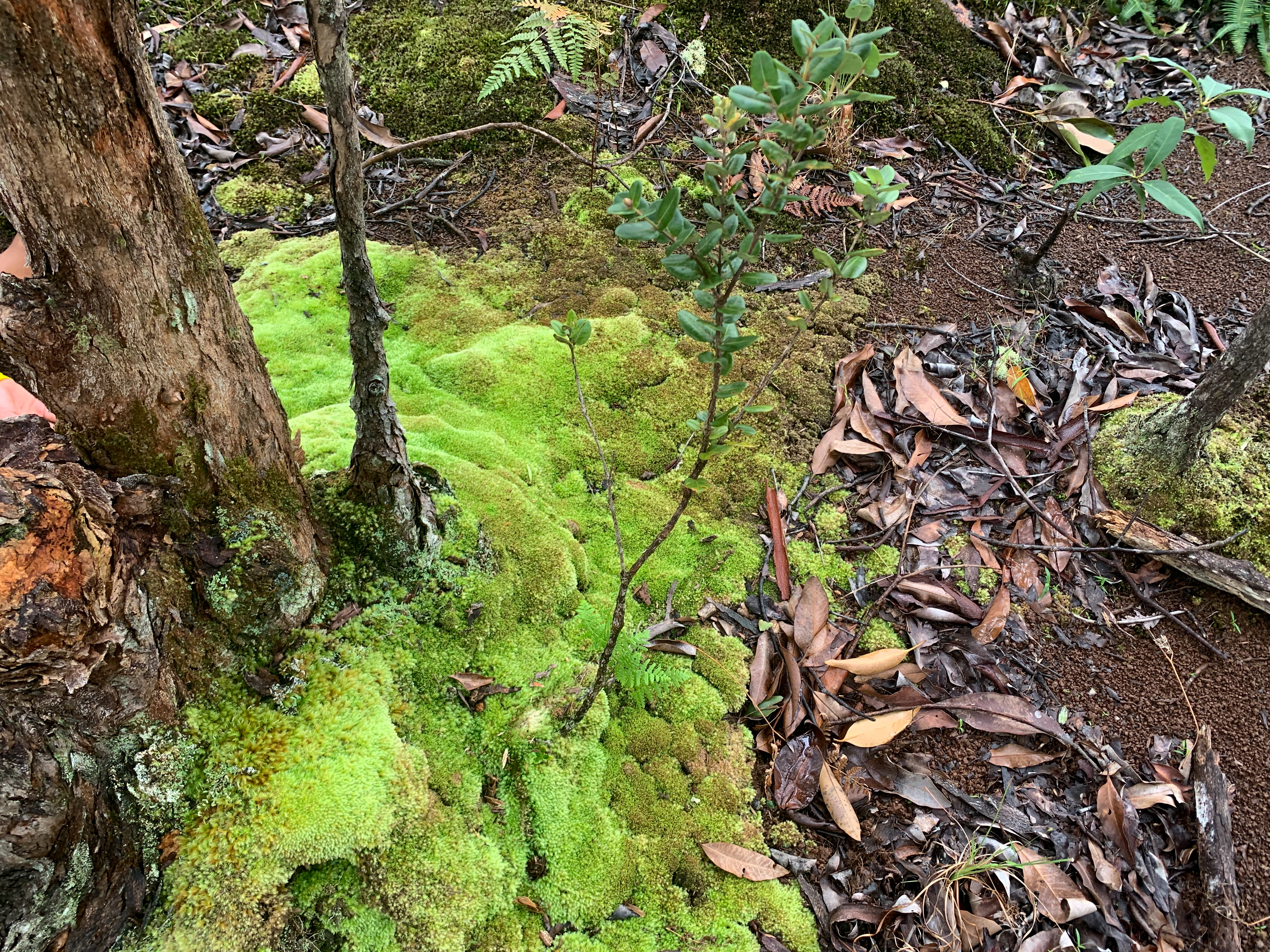
Bryophytes lack vascular tissue which translates into them being short, as they cannot perform any significant vertical transportation of water. Instead, they absorb water directly from their surroundings through osmosis, especially via the lower surface of the leaf. Consequently, they are mostly confined to places where water is readily available. They also require water for sexual reproduction, as bryophyte sperm is flagellated and needs to swim to the egg. With this in mind, in which type of ecosystems would you likely find bryophytes? Here in Hawai‘i, they can be found in areas with high precipitation and high humidity, like on the Windward side of the islands, or along stream banks. On higher elevations where precipitation is high, they can be found growing on rocks and logs on the forest floor. Bryophytes are an ancestral group of plants because besides lacking vascular tissue they also lack true roots and true leaves, which are characteristic of more recent plants. There are three main bryophyte groups (liverworts, hornworts, and mosses), each one possessing easy-to-recognize characteristics (Figure \(\PageIndex{2}\)).
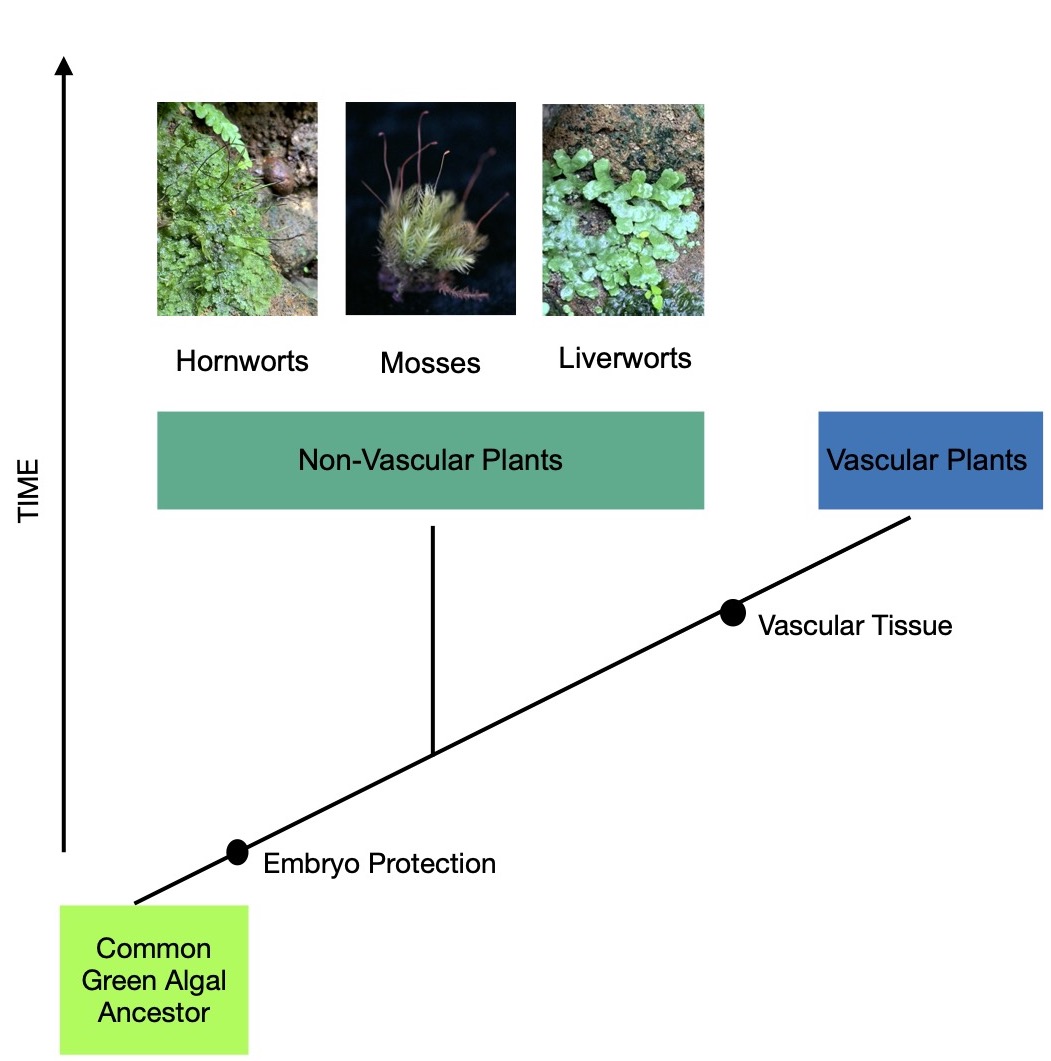
Liverworts (Phylum Hepaticophyta)
There are about 9,000 species of liverworts on Earth (Christenhusz and Byng, 2016). The name of this group originated at a time when botanists thought the shape of a plant could be used to treat diseases of the part of the human body it resembled. In this case, liverworts look like human livers because they are lobed. This method of treating diseases took place in the 15th century and it is no longer an accepted practice, but the name stayed. Liverworts play a crucial role in their habitats. For example, in tropical forests, they play a role in water absorption and retention. In arid regions, they help form a soil crust that allows other species to survive while stabilizing the area.
Some species of liverworts have the characteristic flattened leaf-like body (thallus) from which the group name is derived and are small (less than 10 centimeters or 4 inches) with lobed “leaves” (Figures 6.3.3). Interestingly, most species of liverworts are similar to mosses and can be differentiated from them by the presence of single-cell rhizoids in liverworts (primitive root structure), rather than the multicellular rhizoids present in mosses. This might not be very useful when trying to identify a mossy-looking liverwort in the field because you would need a microscope to see these structures. Some characteristics that can help tell the difference in the field are that most mosses have spirally arranged leaves, a distinct midrib, and, same size leaves.
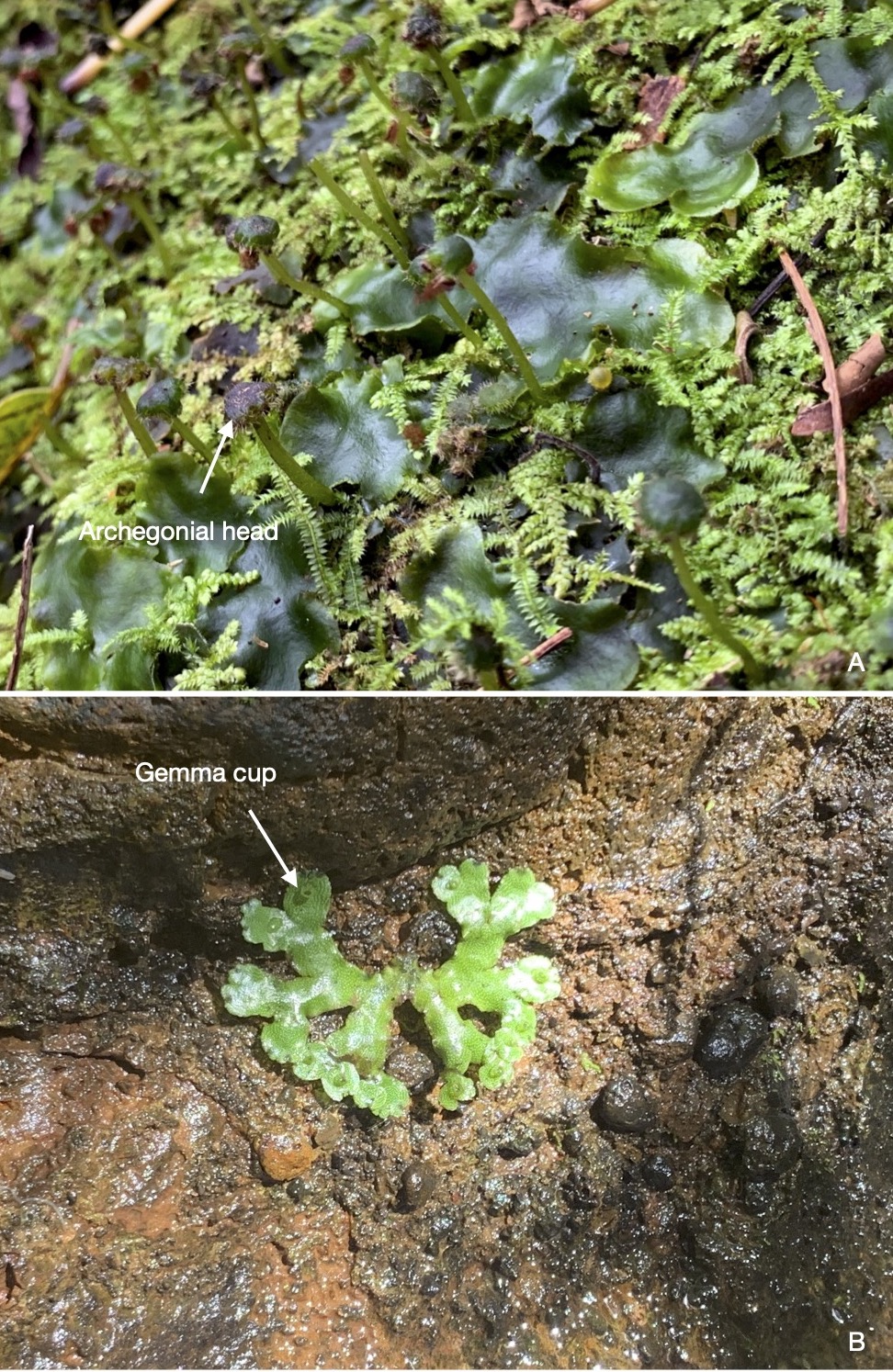
The dominant life stage of a liverwort is the gametophyte, which is the green leafy part of the body. From the gametophytes, they produce the male and female reproductive structures, archegonium and antheridium, respectively. These photosynthetic structures usually tower over the thallus and it is here where eggs and sperm are produced. Liverworts, just like mosses and hornworts, require water for reproduction because the sperm needs to swim to the female structure for sexual reproduction to take place. The sperm swims through a hollow tube in the archegonium (female) to reach the egg. Once fertilization is accomplished, the embryo becomes the diploid sporophyte (2n) and it remains attached to the gametophyte (Figure \(\PageIndex{4}\)).

Liverworts also reproduce asexually, by producing gemmae in cup-like structures on their gametophytes (Figure \(\PageIndex{4}\)). Gemmae are small pieces of haploid tissue that can grow into new gametophytes. Rain usually splashes the gemmae out of the cups, dispersing them to other environments. A few liverworts are very popular in the aquarium hobby as submerged plants or as plants growing in terrariums. Floating crystalwort (Riccia fluitans), Asian liverwort (Monosolenium tenerum), and mini pellia (Riccardia chamedryfolia) are all species used by hobbyists.
Mosses (Phylum Bryophyta)
There are about 12,700 species of mosses in the world (Christenhusz and Byng, 2016). In Hawai‘i, there are approximately 255 species of mosses, consisting of 75 endemic, 166 indigenous, and 14 introduced species (Staples et al., 2004). If you are walking around a wet rural or urban area you will likely find mosses. By looking closely, you may see mosses growing in cracks of a sidewalk or on the bark of trees on the windward side of O‘ahu (Figure \(\PageIndex{5}\)). If the environment is moist enough, mosses will be there. Some moss species can live in drier environments, going dormant during times when water is not available only to spring back to life when it rains.
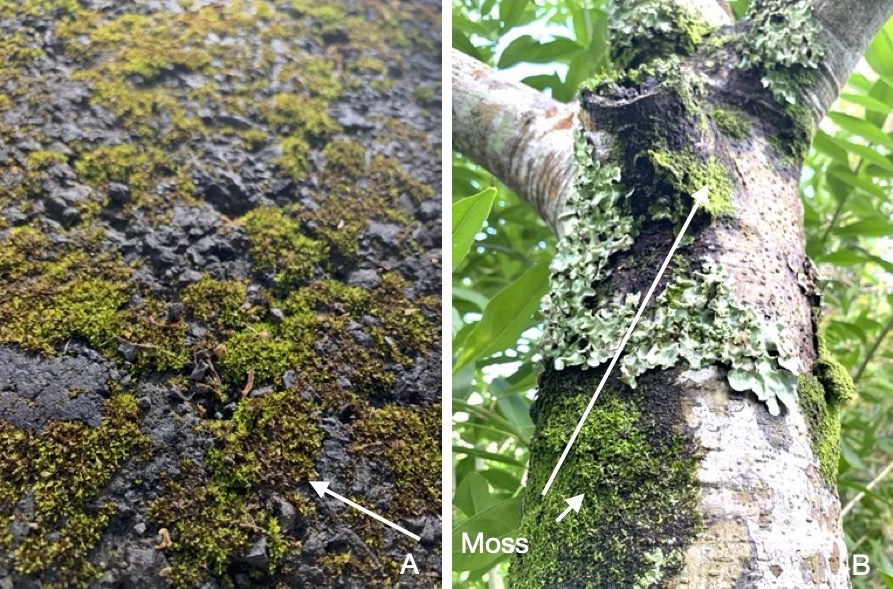
The visible green fluffy plant that we call moss is the gametophyte, which is their dominant stage. Since mosses are part of the bryophyte group, they don’t have true roots to absorb water; instead, they can do it directly from the surface of the gametophyte via osmosis. Once mosses are ready to reproduce, the egg and sperm combine to form a sporophyte that grows from the top of the gametophyte (Figure \(\PageIndex{6}\)) or on lateral areas of the stem in prostrate species, and produces spores, which germinate into male and female gametophytes (Figure \(\PageIndex{7}\)). These, in turn, will produce eggs and sperm that when combined, will give rise to a new sporophyte (the cycle continues!). Sporophytes are not photosynthetic, and they depend on the gametophyte. Some mosses may live a long time without undergoing sexual reproduction. Instead, they form colonies composed of gametophytes. Sometimes small clumps will break off due to a flood or animal disturbance and one of those clumps may start a new colony elsewhere in the process of asexual reproduction via fragmentation.

Mosses are important ecologically for several reasons. They act like sponges that can absorb and retain rainwater. For this reason, they are important in the establishment of epiphytic fern gametophytes because they can retain moisture for prolonged periods so that spores can germinate and develop (McCarthy 2007, Miles Thomas Pers. Com.). They can also serve as a nursery for native seedlings (Rehm et al., 2019; Kimmerer, 2003); when a seed is dispersed, if it finds a moss colony it can be protected from predators and will have a moist environment to develop and grow (Figure \(\PageIndex{8}\)).
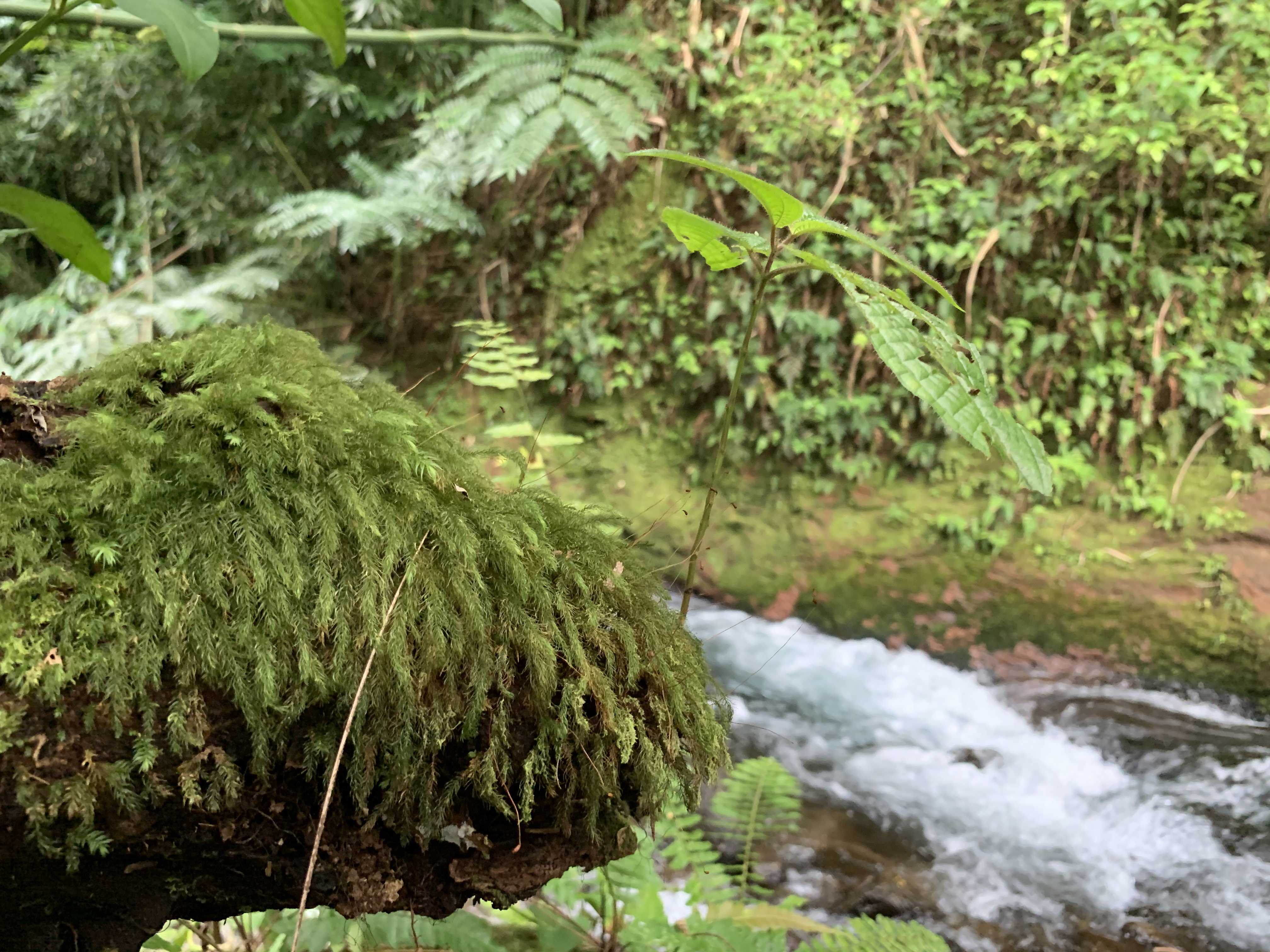
Mosses have been used for quite a long time by humans. Because of their immense absorptive capacity, native people in different regions have used mosses as diapers and for menstrual supplies. Given their antimicrobial properties, they were used as bandages by several native communities and even during WWI (Kimmerer, 2003). They have also been extensively used as packaging material, and even today they are used for live shellfish shipping. Today, mosses are used in the horticultural industry as potting media for plants (peat moss) and decorations. The harvest of moss from natural communities can have a significant impact on these populations because they may take a very long time to recover.
Hornworts (Phylum Anthocerophyta)
There are about 225 species of hornworts worldwide, the smallest group of bryophytes (Christenhusz and Byng, 2016). In Hawai‘i there are a total of 8 species (one endemic, three indigenous, 2 introduced, and two of dubious origin). The sporophyte of this group looks like a little horn, which gave the group its name (Figure \(\PageIndex{9}\)). On the evolutionary scale, hornworts seem to have diverged from the green algae common ancestor much earlier than mosses and liverworts. They have a unique gene not found in mosses or liverworts called LCIB. This gene is also found in algae and is responsible for concentrating carbon dioxide in the chloroplasts of the cells, making the production of sugars more efficient. The gametophyte, which is the dominant stage in hornworts, grows in a loose circular arrangement from where the green photosynthetic horn-like sporophytes grow. Hornworts have stomata in their sporophytes, a feature that is absent in liverworts and most mosses (Figure \(\PageIndex{10}\)).
On O‘ahu, hornworts can be found on stream banks (Figure \(\PageIndex{9}\)), which may be one of the only places they can grow without competition from weeds or leaf cover (Vitt et al., 2018). There, colonization is facilitated by the presence of exposed mineral substrates and microhabitats full of moisture (Figure \(\PageIndex{9}\)).
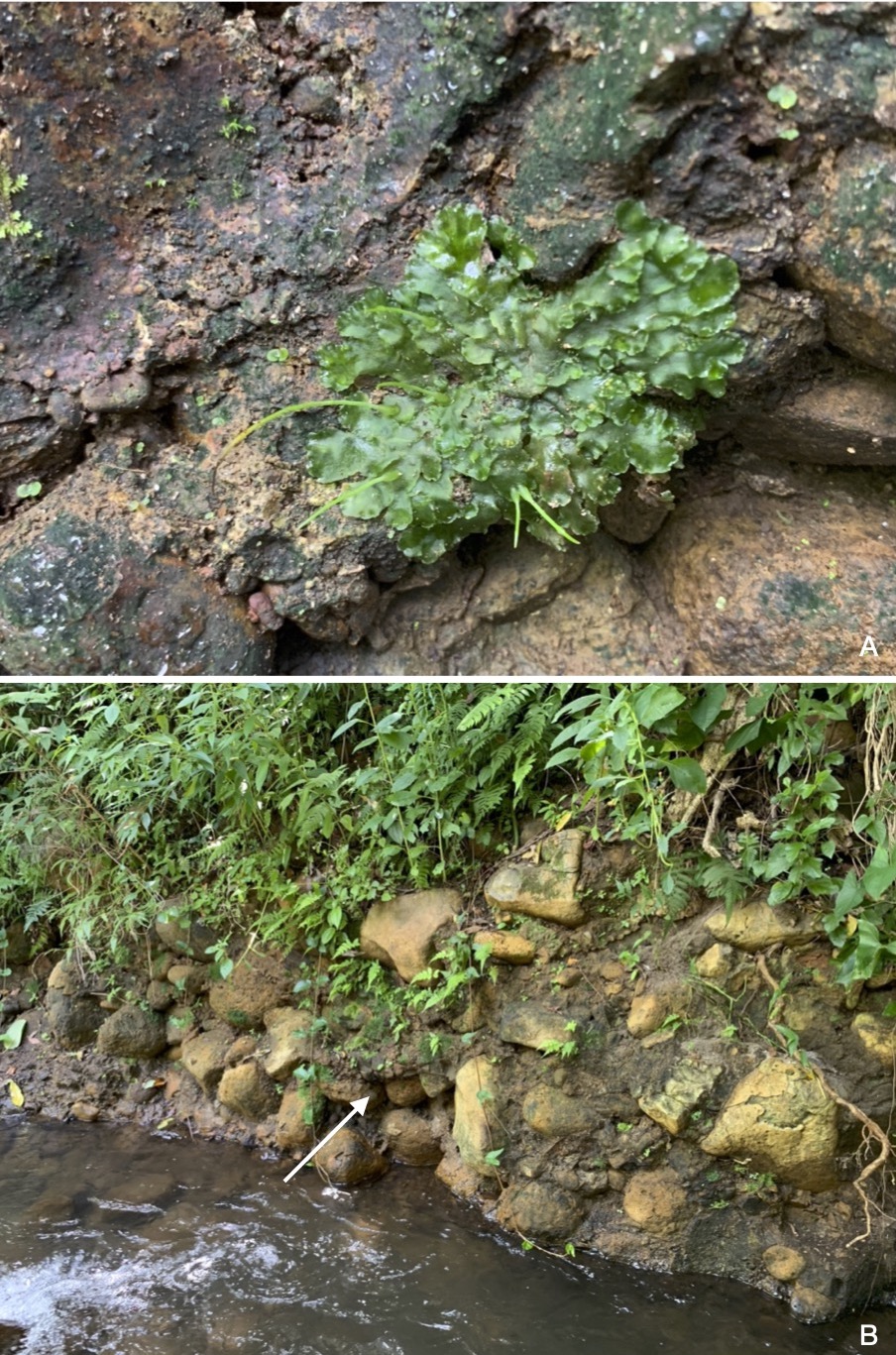
The dominant life stage of a hornwort is the gametophyte (Figure \(\PageIndex{10}\)). From the gametophytes, they produce the male and female reproductive structures, archegonium and antheridium, respectively. These structures are located on the surface of the gametophyte and are where eggs and sperm are produced. Hornworts, just like mosses and liverworts, require water for reproduction because the sperm needs to swim to the female structure for sexual reproduction to take place. Once the sperm reaches the egg and fertilization takes place, a zygote (diploid, 2n) forms which then develops into the sporophyte which remains attached to the gametophyte (Figure \(\PageIndex{10}\)).


